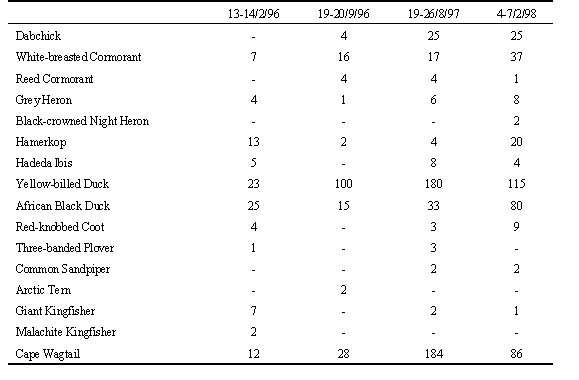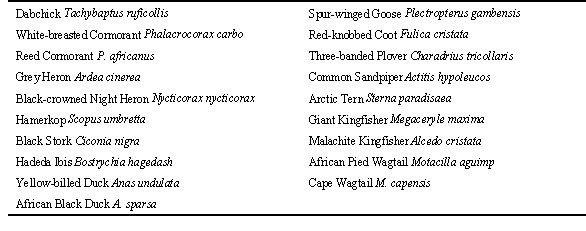
S27.5: Mega-developments and birds: The waterbirds impacted by the Lesotho Highlands Water Scheme as an example
David G. Allan
Avian Demography Unit, University of Cape Town, Rondebosch 7701, South Africa, and Durban Natural Science Museum, PO Box 4085, Durban 4000, South Africa, fax 27 31 300 6302, e-mail davida@durban.gov.za
Allan, D.G. 1999. Mega-developments and birds: The waterbirds impacted by the Lesotho Highlands Water Scheme as an example. In: Adams, N.J. & Slotow, R.H. (eds) Proc. 22 Int. Ornithol. Congr., Durban: 1556-1578. Johannesburg: BirdLife South Africa.The Lesotho highlands is an area of great avifaunal importance. The region is one of the world’s 218 Endemic Bird Areas, as delineated by BirdLife International. It forms the headwaters of the Orange River and is southern Africa’s most important water-catchment region. The area has been targeted for one of the world’s most ambitious dam-building and inter-basin transfer schemes: the Lesotho Highlands Water Project. The first of these mega-dams (Katse Dam) has been completed, the second (Mohale Dam) is under construction, and several more such impoundments are planned. This study details the impact of these dams on the waterbirds of this unique region.
INTRODUCTION
The Orange River is the longest river (1950 km) in southern Africa south of the Zambezi River (Keulder 1979). Most of its 852000 km2 catchment area lies in South Africa and Lesotho, and 47% of the total area of South Africa (and essentially 100% of the area of Lesotho) lies within its catchment (Benade 1988). The Orange River system (including its associated tributary, the Vaal River) carries the highest runoff of any South African drainage region: 22.1% of the national runoff (Noble & Hemens 1978). Its headwaters lie in the highlands of Lesotho.
The headwaters of the Orange River in Lesotho are currently the subject of an ambitious inter-basin water transfer scheme, the Lesotho Highlands Water Project (Davies & Day 1998). A series of large dams will allow the impounded water to be pumped northwards into the upper Vaal River drainage area to meet the water demands of the densely settled and highly industrialised Gauteng region of South Africa, instead of draining naturally to the west along the drainage of the Orange River. The first of these impoundments, Katse Dam (Fig. 1), with the highest dam wall in Africa (187 m), is now complete. It is situated on the Malibamatso River (a major tributary of the Senqu River, as the Orange River is known in Lesotho) at 29o20'S; 28o31'E. Inundation commenced in October 1995 and the dam had reached full capacity by August 1997 (pers. obs.). The altitude of the water level at full capacity is 2050 m above sea-level. The longest ‘arm’ of this dam, extending up the Malibamatso River, measures 50 km in length, with a second, shorter arm extending 18 km up the Bokong tributary. The width of these two arms of the dam, however, is relatively narrow, due to the deeply incised nature of the topography, being typically less than 1 km wide in most places and 2 km in width at its widest points. The second impoundment, Mohale Dam (Fig. 1), on the Senqunyane River (another major tributary of the Senqu River) at 29o28'S; 28o06'E is currently under construction.
The species diversity and abundance of waterbirds occurring at lotic natural wetlands and artificial impoundments in southern Africa is relatively well known. For example, the 1997 report on the African Waterfowl Census project of Wetlands International (Dodman et al. 1997) states that 130 such sites are being censused regularly in South Africa. The waterbirds inhabiting the lentic rivers of the sub-region, however, are less well known. A count of waterbirds along a 160 km stretch of the lower Orange River (Allan & Jenkins 1993) represents one of the few published censuses of riverine waterbird populations. Similarly, the counts of Rock Pratincoles Glareola nuchalis (Williams et al. 1989) and African Skimmers Rynchops flavirostris (Coppinger et al. 1988) along the Zambezi River represent two of the few single-species studies of this nature.
The aims of this study were to:
(1) elucidate the species diversity and abundance of the waterbirds inhabiting the rivers of the Lesotho highlands;
(2) investigate the patterns of seasonality of occurrence and breeding of these birds; and
(3) assess the impact of the inundation of Katse Dam on the waterbirds inhabiting the inundation area.
METHODS
Waterbirds were counted by walking or from horseback along the banks of the rivers. In addition, a long stretch (104 km) of the lower Senqunyane River was counted from a small inflatable boat paddled down the river. These highland rivers flow through open grasslands and have little fringing or emergent vegetation. Visibility therefore is good and it is unlikely that many waterbirds were overlooked during these counts. All details of breeding by waterbirds were also recorded during the counts.
Waterbirds were counted along the Malibamatso (Appendix 1) and Senqunyane (Appendix 2) rivers (Fig. 1) during March and June 1991 (Malibamatso), August and November 1995 and March 1996 (Senqunyane), and February and September 1996 (Malibamatso). The counts in the upper Senqunyane system also included four major tributaries of the Senqunyane: the Jorotane River, an un-named tributary of the Jorotane, the Bokong River (a separate river to the Bokong River in the Malibamatso catchment) and the Likalaneng River. In total, 342.5 km of these rivers were covered, as follows: Malibamatso - 96.0 km and Senqunyane - 246.5 km (Senqunyane - 162.0 km, Jorotane - 44.7 km, un-named tributary of Jorotane - 7.8 km, Bokong - 24.8 km, Likalaneng - 7.2 km). The precise details of latitude or longitude (depending on whether the relevant stretch of river flows north-south or west-east) identifying the stretches of river along which all counts were made are: Malibamatso - 29o01'S to 29o20'S (bridge at Ha Leketlane to present position of Katse Dam wall); Senqunyane - on foot or horseback 29o18'S to 29o28'S (Ha Mothakathi to present position of Mohale Dam wall), boat trip 29o33'S to 30o02'S (bridge close to Ha Marakabei to confluence with Senqu River); Jorotane - 29o18'S to 29o26'S (Ha Setene to confluence with Senqunyane); un-named tributary of the Jorotane - 28o02'E to 28o04'E (Ha Tholoana to confluence with Jorotane); Bokong - 29o19'S to 29o24'S (Ha Koko Raloti to confluence with Senqunyane); Likalaneng - 28o03'E to 28o06'E (Ha Mohale to confluence with Senqunyane). The altitude spanned by the stretch of river covered along the Malibamatso River is 1900-2100 m. The altitude spanned by the stretches of river covered in the Senqunyane system is 1950-2275 m for the upper reaches covered on foot or on horseback and 1525-1800 m for the lower Senqunyane covered by boat. The seasonal breakdown of these counts was: November to January - 50.7 km, February to April - 146.5 km, May to July - 27.0 km, August to October - 118.3 km.
Four counts of the waterbirds on Katse Dam were made, in February 1996, September 1996, August 1997 and February 1998 (Appendix 3). In August 1997 and February 1998 the dam was at full capacity and covered about twice the surface area found during the February and September 1996 counts. The first count (February 1996) was made using a small canoe which was paddled from the upper reaches of the Malibamatso and Bokong arms of the dam to the dam wall. The subsequent three counts were made using small boats with powered outboard engines which were steered around the entire perimeter of the dam. All details of breeding by waterbirds were also recorded during these counts.
A total of 19 waterbird species were found and included in the river and dam counts during the course of this study. These are listed, along with their scientific names, in Table 1. The Black-headed Heron Ardea melanocephala is sometimes regarded as a waterbird and is present in the Lesotho highlands but it was not included here as it forages primarily in dryland habitats (Maclean 1993). The White-throated Swallow Hirundo albigularis and Brown-throated Martin Riparia paludicola can be classed as true waterbirds, as they forage primarily over aquatic habitats (Maclean 1993). These two species both occur in the Lesotho highlands but are also not considered here.
RESULTS AND DISCUSSION
Waterbird species diversity and abundance on the rivers
Waterbird species diversity is relatively low along these rivers and only 15 species were found during the counts (Fig. 2). Of these, the Cape Wagtail Motacilla capensis was the most common, followed by the African Black Duck Anas sparsa. One species, the Spur-winged Goose Plectropterus gambensis, was represented by a single sighting of a solitary bird and this species can be considered a vagrant to the area; indeed this appears to be the first record of this bird in the Lesotho highlands (Osborne & Tigar 1990; Bonde 1993; Maclean 1997). Overall, the waterbird densities were also low with all species, except for the Cape Wagtail and African Black Duck, occurring at linear densities of less than two birds per 10 km of river.
Ignoring the vagrant Spur-winged Goose, these waterbird species appeared to be widespread throughout the two river systems, except for the African Pied Wagtail M. aguimp, which was localised to the very lowest parts of the Senqunyane, just before it enters the Senqu River. In this area, the Senqunyane flows over a sandstone, rather than basalt, substrate. The African Pied Wagtail was fairly common in this region, with 22 birds being counted along about 38 km of river. It was also noted to extend further downstream along the Senqu River, which also flows mainly over sandstone in this region, with an additional 62 birds being counted along about 131 km of the Senqu. Remarkably, this population of African Pied Wagtails appears to have been widely overlooked in Lesotho. Osborne & Tigar (1990) and Bonde (1993) report only five previous records for the entire country: Mohales Hoek, Maseru (twice), and Koma Koma Bridge on the Senqu River (twice), with the first-mentioned authors stating that this was despite their searches along the Senqu and other major rivers in central Lesotho.
Seasonality of occurrence of waterbirds on the rivers
The total number of waterbird species present changed little throughout the year, varying between eight and eleven species recorded (Fig. 3). The number of birds counted, however, was much higher in the late-summer (February-April) to winter (May-July) period than at other times of the year. This may be because the rivers tend to be swollen and highly turbid during the spring to early summer high-rainfall season. Unfortunately the sample size for the May-July period was low (27 km) weakening the reliability of this comparison. These seasonality data on species diversity and abundance exclude the Cape Wagtail (Fig. 3). Only one species, the Common Sandpiper Actitis hypoleucos, is known to be a long-distance, regular migrant (Maclean 1993).
Examining the seasonality data individually for each of the eight most common waterbird species for which sample sizes are the largest (Fig. 2), shows that six of these species (White-breasted Cormorant Phalacrocorax carbo, Grey Heron A. cinerea, Hamerkop Scopus umbretta, Yellow-billed Duck Anas undulata, African Black Duck, Giant Kingfisher Megaceryle maxima) conform to this trend of a late-summer to winter increase in abundance (Fig. 4), although the data for the Hamerkop show a marginally higher abundance in August-October than in February-April. Of the eight most common species, only the Three-banded Plover Charadrius tricollaris and Cape Wagtail show a late-summer to winter decrease in abundance (Fig. 5a and Fig 5b). Four of the six species (White-breasted Cormorant, Grey Heron, Hamerkop, Giant Kingfisher) that increase in late-summer to winter feed on fish, frogs and crabs (Maclean 1993), and may favour the lower and clearer water at this time for hunting. The Yellow-billed Duck feeds on aquatic plant material. The diet of the African Black Duck is chironomid larvae and aquatic plant material, the former obtained from under stones in river rapids (Brown et al. 1982; Maclean 1993) again perhaps most easily harvested under low and clear water conditions. The Three-banded Plover and Cape Wagtail both feed on insects (Maclean 1993) and the cooler winter temperatures are likely to reduce their food supply during that period.
Waterbird species diversity on Katse Dam
Sixteen species of waterbirds were found during the four counts at Katse Dam (Fig. 6). One of these (not shown in Fig. 6), the Arctic Tern Sterna paradisaea, was an extraordinary record of two vagrant birds seen on 19 September 1996 and represented the first record of this species for Lesotho (Allan & Jenkins 1997). The suite of species recorded on the dam was similar to that found on the rivers and of the remaining 15 species, 12 were also counted along the rivers (Fig 2 and Fig 6). The three species recorded on the rivers and not found on the dam were: Spur-winged Goose (recorded only once as a vagrant on the Jorotane River), African Pied Wagtail (which was restricted to the lower Senqunyane), and Black Stork Ciconia nigra (discussed further below).
Three waterbird species not recorded on the rivers were found on Katse Dam after its inundation (Fig. 6). These were: Dabchick Tachybaptus ruficollis, with four birds counted in September 1996, 25 in August 1997 and 23 in February 1998 (none were recorded on the first count of the dam in February 1996); Black-crowned Night Heron Nycticorax nycticorax, with two birds recorded in February 1998; and Red-knobbed Coot Fulica cristata, with four birds recorded in February 1996, three in August 1997 and nine in February 1998. The Dabchick would appear to be a permanent colonist since September 1996. The Red-knobbed Coot is also likely to be a permanent colonist (although it was absent during the September 1996 count). Further counts are required to determine the status of the Black-crowned Night Heron. A preference for lotic over lentic conditions is well known for the Dabchick (Dean 1997) and Red-knobbed Coot (Taylor 1998), and may also be true for the Black-crowned Night Heron (Martin 1997). There are no previous records of the Black-crowned Night Heron from the Lesotho highlands (Osborne & Tigar 1990; Bonde 1993; Martin 1997). There is only a single previous record of the Dabchick from the Lesotho highlands, at 2250-2500 m (Osborne & Tigar 1990). The Red-knobbed Coot has been recorded from the Lesotho highlands on several previous occasions, even at altitudes exceeding 2750 m (Osborne & Tigar 1990; Bonde 1993). The colonisation of the dams of the Lesotho Highlands Water Project by the Dabchick and Red-knobbed Coot was predicted by Osborne & Tigar (1990).
Waterbird abundance on Katse Dam
The information on the relative abundance of each of the 15 species (ignoring the vagrant Arctic Terns) counted on Katse Dam during each of the four counts (Fig. 6) shows relatively high variation between the counts in the numbers of each waterbird species present. Overall, the first two counts, when the dam was still filling and was at about half capacity, showed lower species diversity and abundance compared with the last two counts, when the dam was at full capacity: February 1996 - 11 spp., 103 individual birds; September 1996 - 8 spp., 170 individual birds; August 1997 - 13 spp., 479 individual birds; February 1998 - 13 spp., 391 individual birds. The remarkably low numbers of Cape Wagtails present on the dam during the first count, and to a lesser extent the second count, when inundation was first underway, followed by a dramatic subsequent increase is noteworthy (Fig. 6): 21.9 birds per 10 km of river decreased to 3.0 birds/10 km of dam in February 1996 and 7.0 birds/10 km of dam in September 1996, subsequently increasing to 27.1 birds/10 km of dam in August 1997.
A comparison of the relative abundance of the 16 waterbird species found on the Malibamatso River and/or on Katse Dam (ignoring the vagrant Arctic Terns) between the two habitats to gauge the impact of inundation is of interest (Fig. 7). The information for the dam in Fig. 7 is restricted to the last two counts (August 1997 and February 1998) when the dam was at full capacity. These data are not amenable to formal statistical testing.
The four most common species on the dam were also the four species most common on the river (White-breasted Cormorant, Yellow-billed Duck, African Black Duck, Cape Wagtail). The Yellow-billed Duck showed a large-scale increase in abundance with the inundation of the dam and replaced the Cape Wagtail as the most common species. The Cape Wagtail occurred at similar densities on both the river and the dam. The African Black Duck, the second-most common species on the river and the third-most common on the dam, also appeared to show little change in abundance with inundation. This result is most surprising as this duck is widely regarded as a specialist of riverine lentic conditions (Brown et al. 1982; Maclean 1993) and was expected to largely vacate the inundated region. The White-breasted Cormorant also showed little change in abundance with the inundation of the dam. The fifth-most abundant species on the dam was the Dabchick, which was entirely absent from the rivers.
Arbitrarily assigning a threshold of a 50% or more increase or decrease in relative abundance on the dam relative to the river as reflecting a reliable change in status suggests that, with inundation, three species have colonised the area (Dabchick, Black-crowned Night Heron, Red-knobbed Coot), two have increased in abundance (Reed Cormorant Phalacrocorax africanus, Yellow-billed Duck), two have decreased in abundance (Three-banded Plover, Giant Kingfisher), two have deserted the area (Black Stork, Malachite Kingfisher Alcedo cristata), and the abundance of seven species appears unchanged (White-breasted Cormorant, Grey Heron, Hamerkop, Hadeda Ibis Bostrychia hagedash, African Black Duck, Common Sandpiper, Cape Wagtail). The eight species found to be most abundant on the rivers generally, i.e. with the Malibamatso and Senqunyane-system data combined, were the same eight species most abundant on the Malibamatso and, of these, one has increased in abundance (Yellow-billed Duck), two have decreased in abundance (Three-banded Plover, Giant Kingfisher), and the abundance of five appears unchanged (White-breasted Cormorant, Grey Heron, Hamerkop, African Black Duck, Cape Wagtail). The sample sizes for the other eight species (except for the colonising Dabchick and Red-knobbed Coot) shown in Fig. 7 are small and conclusions regarding their responses to inundation should be treated cautiously.
Breeding status of the waterbirds
Details of breeding are presented separately for each waterbird species below.
Dabchick
A pair of Dabchicks at a nest containing fresh eggshells (the young were probably hidden in nearby flooded vegetation) was found at Katse Dam during February 1998. This species therefore has not only colonised the region but now also breeds there.
White-breasted Cormorant
Three breeding sites of this species were found on the rivers.
A colony of four active nests was found on a cliff over the Malibamatso River in June 1991 at 29o02'S; 28o32'E (and about 3.5 km upstream of the subsequent highest point of inundation of the dam at full capacity). This site was re-visited in September 1996 (when the dam was half full) and three adults and eight recently fledged young from five nests were present. In February 1998 (when the dam was a full capacity), outside the main winter breeding period of this species, nine birds were present at the colony, several of which were recently fledged young, and one active nest (adult sitting) was seen.
Two breeding sites on cliffs over the lower Senqunyane River, 2.5 km apart, were found in March 1996. One was a colony at 29o51'S; 28o13'E and contained 16 nests, five of which had adults attending them (three of which were sitting). The other comprised a single nest with an attendant adult at 29o52'; 28o15'E. This species was not found breeding in the upper Senqunyane area.
In August 1997 one active nest (adult sitting) in a partially submerged alien willow tree Salix babylonica was found on Katse Dam (at 29o17'S; 28o23'E), which was at full capacity.
Reed Cormorant
No evidence of breeding was forthcoming during this study and it is considered unlikely that this species breeds in the area.
Grey Heron
This species was not found breeding along the rivers but the inundation of Katse Dam resulted in several breeding attempts there in partially submerged willow trees. In February 1996 (when the dam was half full) a nest with two young was found at 29o13'S; 28o29'E. In August 1997 (when the dam was at full capacity) a colony of three nests, all probably with eggs, was found at 29o17'S; 28o23'E.
Black-crowned Night Heron
No evidence of breeding was forthcoming during this study and it is considered unlikely that this species breeds in the area.
Hamerkop
Eight nests were found in willow trees along the Malibamatso River (and associated Bokong tributary) prior to the full inundation of Katse Dam. At least two of these were active (one probably with young in November 1991 and the other with an attendant adult in September 1996). Four nests were found in willow trees along the upper Senqunyane River in 1995 but no evidence of breeding was found for the lower Senqunyane.
The filling of Katse Dam resulted in the inundation of the lower-lying willow trees previously used for breeding along this stretch of river, including all eight that were found in 1991. In February 1996, when the dam was filling, one of these nests was found to be active, although the nest tree was partially submerged. Another newly built nest in a partially submerged willow was found in the upper reaches of the Bokong arm of the dam in February 1996. Both of these nests were totally submerged by September 1996. In August 1997, when the dam was at full capacity, two newly built nests were found, one in a partially submerged willow tree and the other on a cliff over the dam. In February 1998 both of these nests were still present; apparently the only breeding sites of this species on the dam.
Black Stork
A total of only six Black Storks were recorded along the 342.5 km of rivers sampled. This is surprising in that a relatively large number of breeding sites of this species situated on cliff faces were located in the Malibamatso and Senqunyane catchments. Three confirmed breeding sites were found in the Malibamatso catchment (in 1991) and five confirmed and one unconfirmed breeding sites were found in the upper Senqunyane catchment (in 1995) in the area covered on foot and by horseback. The lower Senqunyane River censused by boat was covered outside the breeding period of this species but a further unconfirmed Black Stork breeding site was found there (in 1996). Two of the breeding sites in the Malibamatso catchment were situated on cliffs directly above areas inundated by Katse Dam and both of these sites were found to be inactive after the dam’s inundation (1996 and 1997). The third Malibamatso breeding site, situated well away from the dam (5.5 km), was active in both 1996 and 1997. The Black Stork nests in the Senqunyane system were not revisited subsequent to their location in 1995-1996. It appears likely that the inundation of Katse Dam is responsible for the desertion of the two pairs there. A study of this species in the former Transvaal province of South Africa (Tarboton 1982) implies a close association between this species and lentic, rather than lotic, conditions. The low number of birds actually recorded along the rivers during the waterbird counts, however, suggests that these breeding pairs may forage away from the highland rivers in the surrounding lowland areas. If this is so, it is unclear why the inundation of Katse Dam should have resulted in the apparent desertion of the two pairs that formerly bred there. The Black Stork is the only waterbird species counted along the highland rivers or at Katse Dam during this study that is considered formally threatened in the revised red data list for birds in the region covered by Lesotho, South Africa and Swaziland. This revised red data list is currently being jointly finalised for publication in late 1998 by the Avian Demography Unit at the University of Cape Town, and BirdLife South Africa.
Hadeda Ibis
A disused nest of this species in an alien grey poplar tree Populus canescens (in an area subsequently inundated) was found along the Malibamatso River in 1991. In September 1996, two active nests (one with two young) were found along this river upstream of the partially inundated Katse Dam at that time. The lower of these sites was totally submerged by August 1997 but the upper site is situated well upstream (5 km) of the highest inundation point of the dam at full capacity. This species was not found breeding in the Senqunyane system but the lower Senqunyane was covered outside the normal breeding season of this bird.
In the actual inundation area of Katse Dam, two nests were found in February 1996, one under construction in a partially submerged willow tree and the other with two young in a partially submerged poplar tree. In September 1997, both of these sites were totally submerged. In August 1997, with the dam at full capacity, the latter breeding pair was found to have built a nest (with an adult sitting) on a cliff directly above their former breeding site which was in a poplar tree. In February 1998, this nest held large young. This represents the first record of this species nesting on a cliff (Hancock et al. 1992).
Yellow-billed Duck
This species was not found breeding along the rivers but the inundation of Katse Dam resulted in regular breeding on the dam. In February 1996 two different adults were found with six small, and seven large, young respectively. In February 1998 three instances of breeding were recorded: a group of five adults accompanied by one small young, a pair with one large young, and a single adult with one small young.
African Black Duck
In November 1991 a pair of African Black Ducks on the Malibamatso River were suspected of having small young (distraction display noted). In August 1995 a single adult was accompanied by seven small young on the upper Senqunyane River. No breeding was noted on the lower Senqunyane but this area was covered out of the normal breeding season of this species. There is only one previous record of breeding by this species in Lesotho (Osborne & Tigar 1990; Bonde 1993).
In September 1996 an adult accompanied by one small young was found on Katse Dam and in August 1997 a pair with four small young were found on the dam. These breeding records are surprising as this species was expected to largely vacate the inundated area, as discussed above.
The African Black Duck is a territorial species usually encountered in pairs (Maclean 1993). A comparison of the population structure of the African Black Ducks counted on the Malibamatso River prior to any inundation (i.e. from the 1991 counts) and subsequently on the dam (Table 2) revealed a significant increase in the proportion of single birds encountered on the dam compared with on the river (c 22 = 14.1, P < 0.01). Therefore, although the abundance of this species appeared relatively unchanged in the inundation area, it was likely that significantly fewer breeding pairs were present.
Spur-winged Goose
There was no evidence for this vagrant species breeding in the study area.
Red-knobbed Coot
Although this species has colonised Katse Dam, there is no evidence to date of its breeding there.
Three-banded Plover
There was no evidence of breeding by this species on either the rivers or the dam although it is likely do so, at least along the rivers.
Common Sandpiper
This species is a non-breeding Palearctic migrant to southern Africa.
Arctic Tern
This species is also a non-breeding migrant to the southern Africa region (and an exceptional vagrant to Lesotho).
Giant Kingfisher
There was no evidence of breeding by this species on either the rivers or the dam although it is likely do so, at least along the rivers.
Malachite Kingfisher
There was no evidence of breeding by this species on either the rivers or the dam although it may do so, at least along the rivers.
African Pied Wagtail
There was no evidence of breeding by this species in the lower Senqunyane region but this stretch of river was covered outside its normal breeding period and it is likely to breed there. It has been recorded breeding on the nearby Senqu River in January (Osborne & Tigar 1990).
Cape Wagtail
Six active nests of this species were found in the Malibamatso area in 1991, with eggs in November (n = 1) and young in November (n = 4) and March (n = 1). It was not found breeding along the Malibamatso River subsequently, in the Senqunyane system or at Katse Dam but nesting was probably overlooked.
Of the 15 waterbird species recorded along the rivers, six were confirmed to breed (White-breasted Cormorant, Hamerkop, Black Stork, Hadeda Ibis, African Black Duck, Cape Wagtail), three probably breed (Three-banded Plover, Giant Kingfisher, African Pied Wagtail), one may breed (Malachite Kingfisher), and five are non-breeding visitors/vagrants (Reed Cormorant, Grey Heron, Yellow-billed Duck, Spur-winged Goose, Common Sandpiper).
With the flooding of Katse Dam, the breeding status of several species altered in the inundation area. The Dabchick colonised the dam as a breeding species. The existing White-breasted Cormorant colony close to the dam appeared unaffected and a single pair was attracted to breed at the dam. The Grey Heron and Yellow-billed Duck changed from non-breeding visitors to breeding species. The number of Hamerkop nests in the inundation area decreased from eight to two, and the number of Black Stork breeding pairs decreased from two to nil. It is likely that conditions in the inundation area are also less favourable for the Hadeda Ibis, due to the submergence of trees formerly used as breeding sites. It therefore should be noted that, although the White-breasted Cormorant and Grey Heron appeared unchanged in abundance on the dam with inundation, they seemed to benefit from the breeding opportunities resulting from impoundment. By contrast, the Hamerkop, and probably also the Hadeda Ibis, which were also apparently unchanged in abundance with inundation, were negatively impacted relevant to their breeding status. The African Black Duck, surprisingly, remains as a breeding species in the inundation area but appears to have undergone a negative shift in population structure, with a larger proportion of single birds present. The observations during the inundation of Katse Dam showed the attraction of partially submerged trees as nest sites for several species: White-breasted Cormorant, Grey Heron, Hamerkop and Hadeda Ibis. This benefit, however, is short-lived as these trees were either subsequently totally submerged or, for those in the highest reaches, are likely to die and rot away in the long-term.
CONCLUSION
This study has demonstrated that, not surprisingly, Katse Dam has influenced the diversity and abundance of waterbird populations in the inundation area. Some species have disappeared or decreased in abundance, others have colonised or increased in abundance, and, unexpectedly considering the extent of the habitat modification, the status of others has remained relatively unchanged. Alterations have included changes in the breeding status and population structure of certain species. Overall, the waterbird population changes to date are perhaps less dramatic than might have been expected. The impact of the dam on the waterbird populations in the inundation area is summarised in Table 3. Considering both changes in abundance and in breeding status of the relevant 16 species (ignoring the vagrant Spur-winged Goose and Arctic Tern, and the African Pied Wagtail localised to the lower Senqunyane), seven species have benefitted by the dam, seven have been negatively impacted, and the status of two appears largely unchanged. It should be noted that one of the waterbirds apparently most negatively impacted (Black Stork) is a threatened red data species.
It is well-known that the biology of a newly constructed impoundment in the initial years of its existence usually differs from the more stable condition it acquires in the long term (Davies & Day 1998). In particular, the high nutrient levels originating from the large amounts of flooded vegetation during initial inundation dissipate after a few years, usually resulting in much lower levels of nutrient cycling. This is likely to be reflected in the waterbird populations over time. The use of partially submerged trees for breeding by certain species during the inundation phase is a further example of a short-term impact of the dam. It is also possible that many species are showing a time-lag in their responses to inundation. The inundated area may not represent suitable habitat in the long term for these species but they may have persisted there during the study period through attachment to their previous breeding territories and limited options for dispersal to other areas where populations may be saturated. This situation may apply in particular to the African Black Duck. It is also possible that further species may colonise the dam and have not yet had sufficient time to do so (note that the large-scale colonisation by the Dabchick was only apparent at least a year after inundation began). Only further monitoring can track future changes.
The biological impact of large impoundments such as Katse Dam is not restricted to the inundation area. Indeed the downstream effects, which can extend over hundreds of kilometres, are often of far greater significance and conservation concern (McCully 1996; Davies & Day 1998). A major flaw of this study is its neglect of any investigation of the impacts of Katse Dam on the waterbird populations found downstream on the Malibamatso River. With the dam now in place, the opportunity for such studies has been lost. The investigation of the lower Senqunyane River below the Mohale Dam site prior to the initiation of the construction of that dam does provide some baseline information on the waterbird populations present there but further work, over a greater seasonal spread, is called for before the impoundment of this dam.
ACKNOWLEDGEMENTS
I thank the following for assistance in the field with these counts: Keith Barnes, Clayton Burne, Callan Cohen, Jessica Hughes, Andrew Jenkins, Greg Kopij, David Maphisa, Rick Nuttall, Wally Petersen, Warwick Tarboton and Phil Whittington. Loxton, Venn & Associates, AfriDev Consultants, in particular Dr Jack Hennessy, and the Lesotho Highlands Development Authority are thanked for making this study possible. Most of the fieldwork for this project was done while the author was employed by the Avian Demography Unit, University of Cape Town, but some fieldwork and the preparation of this manuscript was done while the author was employed by the Durban Natural Science Museum. I thank the directors of both institutions for their support. I am grateful to Immie Mostert and Greg Davies for assistance in preparing this manuscript.
REFERENCES
Allan, D.G. & Jenkins, A.R. 1993. A count of waterbirds along a section of the lower Orange River. Bontebok 8: 33-34.
Allan, D.G. & Jenkins, A.R. 1997. Arctic Terns in Lesotho. Africa - Birds & Birding 2(2): 14-15.
Benade, C. 1988. Episodic flood events in the Orange River system - an ecological perspective. Pretoria; CSIR.
Bonde, K. 1993. Birds of Lesotho - a guide to distribution past and present. Pietermaritzburg; University of Natal Press.
Brown, L.H., Urban, E.K. & Newman, K. 1982. The birds of Africa. Vol. 2. London; Academic Press.
Coppinger, M.P., Williams, G.D. & Maclean, G.L. 1988. Distribution and breeding biology of the African Skimmer on the upper and middle Zambezi River. Ostrich 59: 85-96.
Davies, B. & Day, J. 1998. Vanishing waters. Cape Town; University of Cape Town Press.
Dean, W.R.J. 1997. Dabchick Tachybaptus ruficollis. In: Harrison, J.A., Allan, D.G., Underhill, L.G., Herremans, M., Tree, A.J., Parker, V. & Brown, C.J. (eds) The atlas of southern African birds, Vol. 1: Non-passerines. Johannesburg; BirdLife South Africa: 6-7.
Dodman, T., de Vaan, C., Hubert, E. & Nivet, C. 1997. African Waterfowl Census 1997. Wageningen, Netherlands; Wetlands International.
Hancock, J.A., Kushlan, J.A. & Kahl, M.P. 1992. Storks, ibises and spoonbills of the world. London; Academic Press.
Keulder, P.C. 1979. Hydrochemistry of the upper Orange River catchment. Journal of the Limnological Society of southern Africa 5: 1-4.
Maclean, G.L. 1993. Roberts’ birds of southern Africa. Cape Town; The Trustees of the John Voelcker Bird Book Fund.
Maclean, G.L. 1997. Spur-winged Goose Plectropterus gambensis. In: Harrison, J.A., Allan, D.G., Underhill, L.G., Herremans, M., Tree, A.J., Parker, V. & Brown, C.J. (eds) The atlas of southern African birds, Vol. 1: Non-passerines. Johannesburg; BirdLife South Africa: 146-147.
Martin, A.P. 1997. Black-crowned Night Heron Nycticorax nycticorax. In: Harrison, J.A., Allan, D.G., Underhill, L.G., Herremans, M., Tree, A.J., Parker, V. & Brown, C.J. (eds) The atlas of southern African birds, Vol. 1: Non-passerines. Johannesburg; BirdLife South Africa. 68-69.
McCully, P. 1996. Silenced rivers. London; Zed Books.
Noble, R.G. & Hemens, J. 1978. Inland water ecosystems in South Africa - a review of research needs. South African National Scientific Programmes Report 34: 1-150.
Osborne, P.E. & Tigar, B.J. 1990. The status and distribution of birds in Lesotho. Alexander Library, Department of Zoology, Oxford University, Oxford (unpublished manuscript).
Tarboton, W.R. 1982. Breeding status of the Black Stork in the Transvaal. Ostrich 53: 151-156.
Taylor, P.B. & van Perlo, B. 1998. Rails - a guide to the rails, crakes, gallinules and coots of the world. Sussex; Pica Press.
Williams, G.D., Coppinger, M.P. & Maclean, G.L. 1989. Distribution and breeding of the Rock Pratincole on the upper and middle Zambezi River. Ostrich 60: 55-64.
Table 1. The 19 waterbird species from the Lesotho highlands included in this study.

Table 2. Group sizes of African Black Ducks on the Malibamatso River in 1991 prior to inundation and on Katse Dam.

Table 3. Summary of the impact of Katse Dam on waterbird species in the inundation area (ignoring the vagrant Spur-winged Goose and Arctic Tern, and the African Pied Wagtail localised to the lower Senqunyane River).
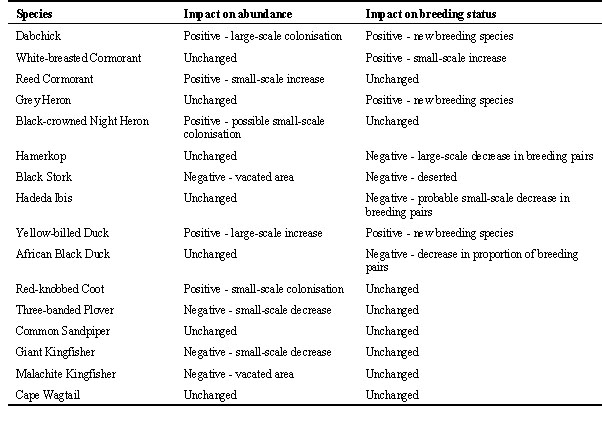
Fig. 1. The location in the Lesotho highlands of the Malibamatso and Senqunyane rivers, and their major tributaries, which were censused for waterbirds during this study, and the location of Katse and Mohale dams.
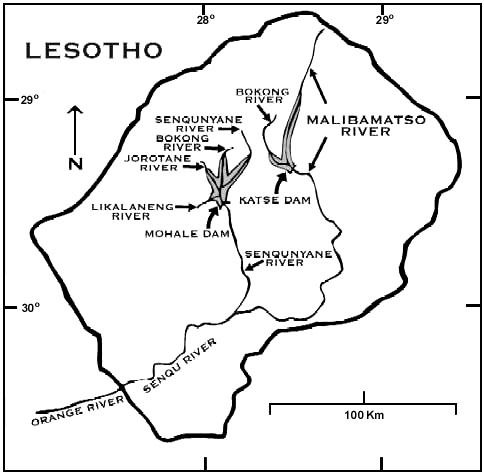
Fig. 2. The 15 species of waterbirds found along the 342.5 km of Lesotho highlands rivers covered during this study, along with the total number of individual birds of each species counted. All species were fairly widespread in the rivers covered, except for the African Pied Wagtail which was restricted to the lower Senqunyane River.
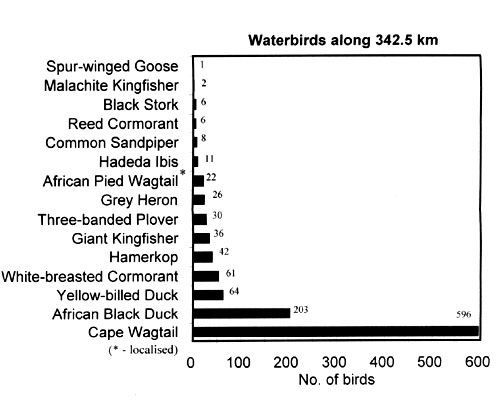
Fig. 3. The species diversity and abundance of waterbirds counted along the Lesotho highlands rivers for four different seasons of the year. Also shown are the sample sizes of river lengths covered during each season. These data do not include information for the Cape Wagtail.
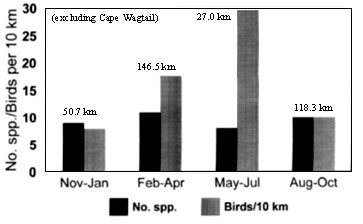
Fig. 4. Seasonal abundance graphs for six waterbird species that showed an obvious increase on the rivers of the Lesotho highlands during the late-summer to winter period (February-July).

Fig 5a and Fig 5b. Seasonal abundance graphs for two waterbird species that showed an obvious decrease on the rivers of the Lesotho highlands during the late-summer to winter period (February-July).
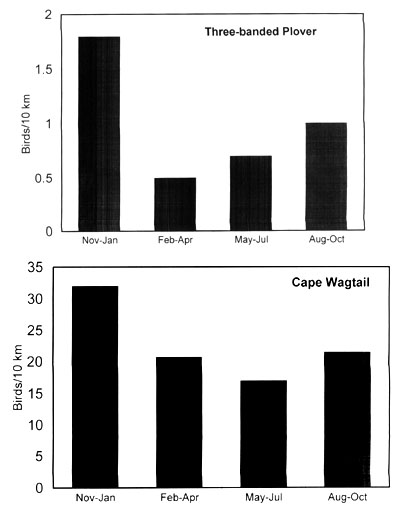
Fig. 6. Abundance data for 15 waterbird species during four counts on Katse Dam in the Lesotho highlands in the post-inundation period (February 1996-February 1998).
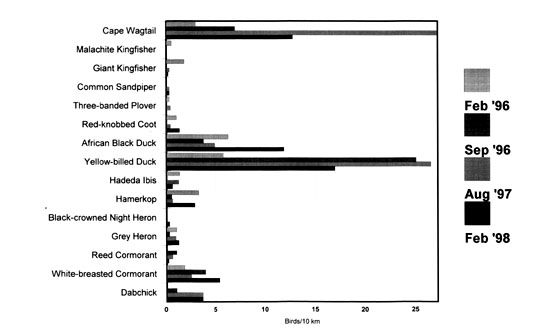
Fig. 7. A comparison of the abundance of 16 waterbird species on the Malibamatso River and on Katse Dam. Note that only data from the August 1997 and February 1998 counts for Katse Dam have been included here.
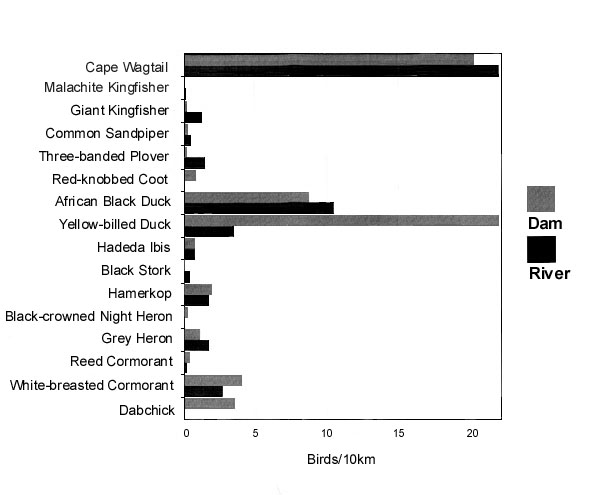
Appendix 1. The dates, lengths of river covered and results of the waterbird counts along the Malibamatso River in the Lesotho highlands during 1991 and 1996.
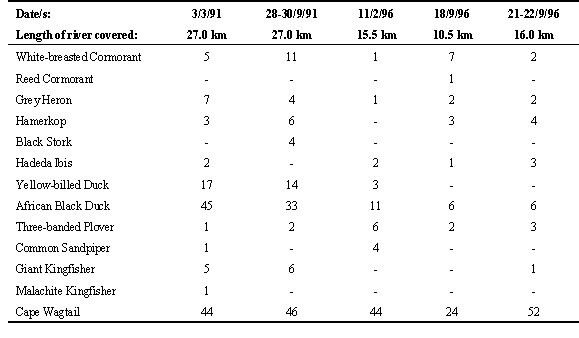
Appendix 2. The dates, lengths of river covered and results of the waterbird counts along the Senqunyane River and its tributaries in the Lesotho highlands during 1995 and 1996.
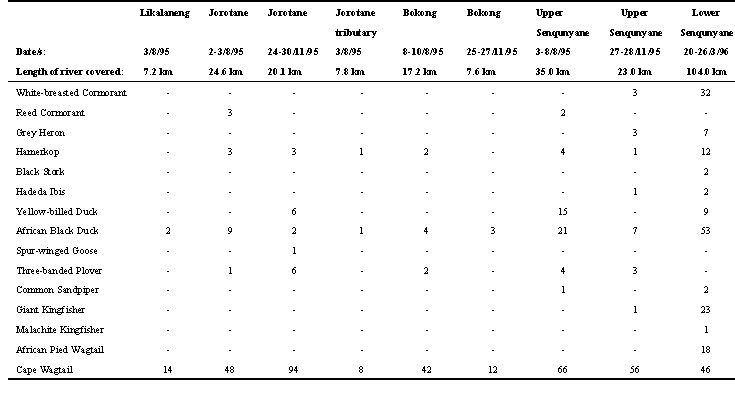
Appendix 3. The dates and results of the four waterbird counts made at Katse Dam in the Lesotho highlands during the period 1996-1998.
